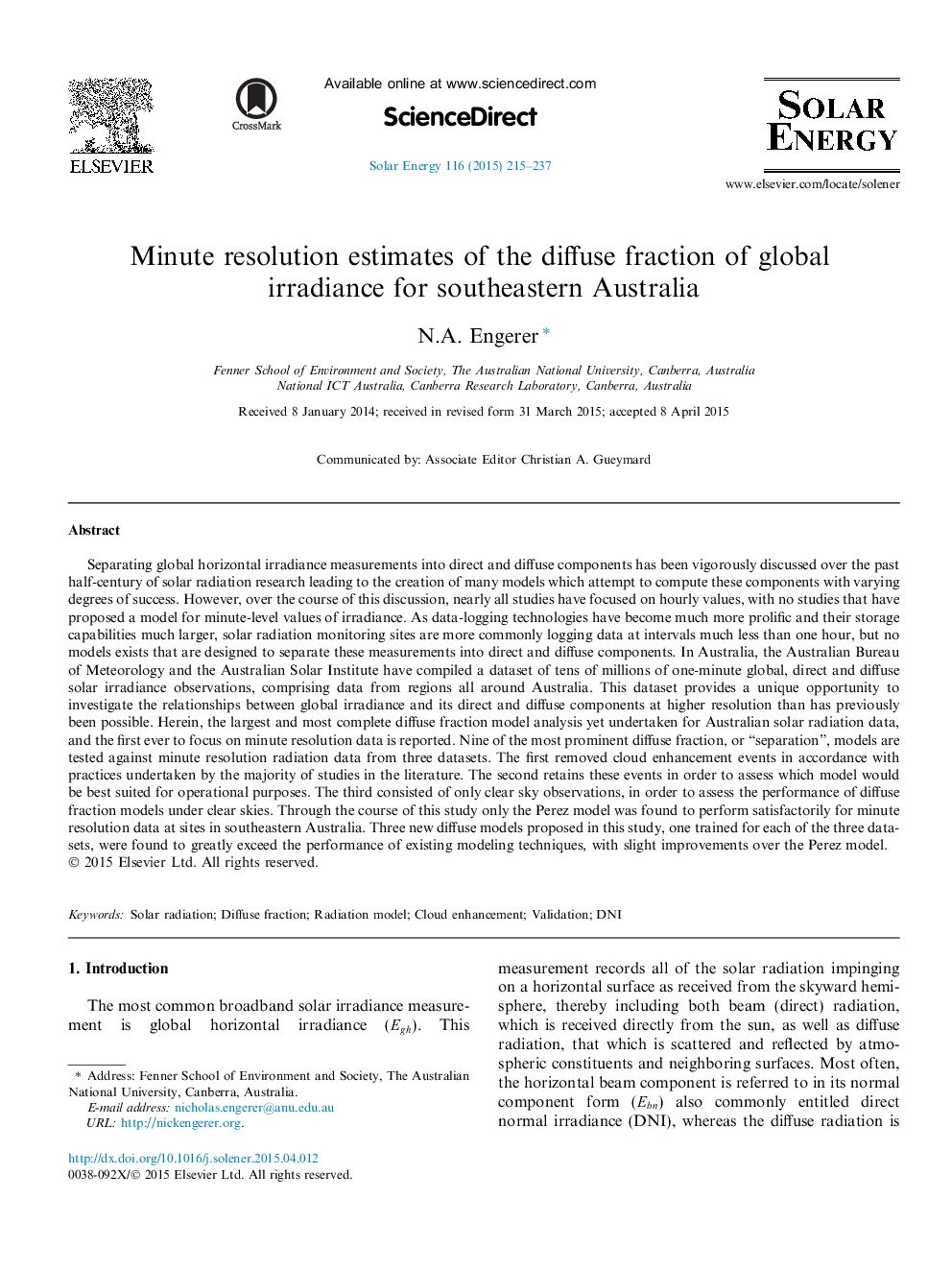| کد مقاله | کد نشریه | سال انتشار | مقاله انگلیسی | نسخه تمام متن |
|---|---|---|---|---|
| 7937853 | 1513102 | 2015 | 23 صفحه PDF | دانلود رایگان |
عنوان انگلیسی مقاله ISI
Minute resolution estimates of the diffuse fraction of global irradiance for southeastern Australia
ترجمه فارسی عنوان
برآورد پراکندگی معکوس از کسر انتشاری تابش جهانی در جنوب شرقی استرالیا
دانلود مقاله + سفارش ترجمه
دانلود مقاله ISI انگلیسی
رایگان برای ایرانیان
کلمات کلیدی
ترجمه چکیده
جداسازی اندازه گیری های تابش افقی جهانی در اجزای مستقیم و توزیع شده در طول نیم قرن گذشته تحقیقات در مورد تابش خورشیدی به شدت مورد بحث و بررسی قرار گرفته است که منجر به ایجاد بسیاری از مدل هایی شده است که تلاش می کنند این اجزا را با درجات مختلف موفقیت محاسبه کنند. با این حال، در طول این بحث، تقریبا تمام مطالعات بر ارزش های ساعتی متمرکز شده است، و هیچ مطالعه ای وجود ندارد که یک مدل برای مقادیر دقیق اشعه را پیشنهاد کند. به عنوان تکنولوژی های ثبت ورود داده ها بسیار پربارتر شده اند و قابلیت ذخیره سازی آنها بسیار بزرگتر است، سایت های نظارت بر تابش خورشیدی معمولا اطلاعات را در فواصل زمانی بسیار کمتر از یک ساعت، اما هیچ مدل وجود ندارد که طراحی شده اند تا این اندازه گیری ها را به قطعات مستقیم و پخش . در استرالیا، اداره هواشناسی استرالیا و مؤسسه خورشیدی استرالیا مجموعه ای از ده ها میلیون یک دقیقه ی مشاهدات جهانی، مستقیم و غیر مستقیم منتشر شده از خورشید را تهیه کرده که حاوی داده هایی از مناطق اطراف استرالیا است. این مجموعه داده یک فرصت منحصر به فرد برای بررسی ارتباطات بین تابش جهانی و اجزای مستقیم و توزیعش با وضوح بالاتر فراهم می کند که قبلا امکان پذیر است. در اینجا، بزرگترین و جامع ترین تجزیه و تحلیل مدل کراس پراکنده هنوز برای داده های تابش خورشیدی استرالیا مورد استفاده قرار گرفته است، و برای اولین بار به تمرکز بر داده های وضوح دقیقه گزارش داده شده است. نه از برجسته ترین بخش فشرده، یا جداسازی، مدل ها در برابر داده های تابشی با وضوح دقیق از سه مجموعه داده ها آزمایش شده اند. اولین رویدادهای تقویت ابر تقویت شده مطابق با شیوه های انجام شده توسط اکثر مطالعات در ادبیات است. دوم این حوادث را حفظ می کند تا ارزیابی شود که کدام مدل برای اهداف عملی مناسب باشد. سومین نظرسنجی دقیق آسمان هاست، به منظور ارزیابی عملکرد مدل های کسر پراکنده در آسمان های روشن. در طی این مطالعه تنها مدل پرز برای رضایت بخش بودن داده های رزولاسیون دقیقه در سایت های جنوب شرقی استرالیا انجام شده است. سه مدل جدید منتشر شده پیشنهاد شده در این مطالعه، که برای هر کدام از سه مجموعه داده شده آموزش دیده است، به میزان قابل توجهی از عملکرد تکنیک های مدل سازی موجود، با پیشرفت های جزئی در مدل پرز، فراتر رفته است.
موضوعات مرتبط
مهندسی و علوم پایه
مهندسی انرژی
انرژی های تجدید پذیر، توسعه پایدار و محیط زیست
چکیده انگلیسی
Separating global horizontal irradiance measurements into direct and diffuse components has been vigorously discussed over the past half-century of solar radiation research leading to the creation of many models which attempt to compute these components with varying degrees of success. However, over the course of this discussion, nearly all studies have focused on hourly values, with no studies that have proposed a model for minute-level values of irradiance. As data-logging technologies have become much more prolific and their storage capabilities much larger, solar radiation monitoring sites are more commonly logging data at intervals much less than one hour, but no models exists that are designed to separate these measurements into direct and diffuse components. In Australia, the Australian Bureau of Meteorology and the Australian Solar Institute have compiled a dataset of tens of millions of one-minute global, direct and diffuse solar irradiance observations, comprising data from regions all around Australia. This dataset provides a unique opportunity to investigate the relationships between global irradiance and its direct and diffuse components at higher resolution than has previously been possible. Herein, the largest and most complete diffuse fraction model analysis yet undertaken for Australian solar radiation data, and the first ever to focus on minute resolution data is reported. Nine of the most prominent diffuse fraction, or “separation”, models are tested against minute resolution radiation data from three datasets. The first removed cloud enhancement events in accordance with practices undertaken by the majority of studies in the literature. The second retains these events in order to assess which model would be best suited for operational purposes. The third consisted of only clear sky observations, in order to assess the performance of diffuse fraction models under clear skies. Through the course of this study only the Perez model was found to perform satisfactorily for minute resolution data at sites in southeastern Australia. Three new diffuse models proposed in this study, one trained for each of the three datasets, were found to greatly exceed the performance of existing modeling techniques, with slight improvements over the Perez model.
ناشر
Database: Elsevier - ScienceDirect (ساینس دایرکت)
Journal: Solar Energy - Volume 116, June 2015, Pages 215-237
Journal: Solar Energy - Volume 116, June 2015, Pages 215-237
نویسندگان
N.A. Engerer,
